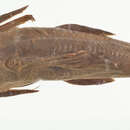Diagnostic Description
provided by Fishbase
Diagnosis: head broad (width at least 2/3 of length); snout length less than 0.9 times head width; hind margin of adipose fin nearly straight; premaxillary dentition forming (in adults) 2 well separated, kidney-shaped plates; maxillary barbels never black and reaching at least to hind margin of eye; 8-11 (usually 9 or 10) gill rakers on lower limb of first gill arch; palatine membrane bilobed (with a large and a smaller lobe); dorsal margin of cleithral process broad and flat (visible only in adults)(Ref. 57126).Description: body rather deep (about 4-5 times in standard length); occipital process broad (ratio width/length from 0.9 (juveniles) to 1.3 (adults), rather rounded and contiguous to the concave-edged first nuchal plate; dorsal fin with 2 spines, the first small, the second strong and denticulate; adipose fin high, increasing steeply backwards, its posterior margin rather straight; palatine membrane with a well developed lobe, and sometimes, a smaller lateral lobe; dorsal process of cleithrum flat and broad (visible only in adults); premaxillary dentition forming a small band (twice as long as broad) in juveniles, developing with growth into 2 small, well separated tooth plates, the entire band being 1.4-1.8 times as long as broad; head broad (width 65-75% of length), snout short (50-68% of head length), showing no great differences between juveniles and adults; nasal barbels absent; pelvic fin with 1 unbranched and 5 branched soft rays (Ref. 57126).Coloration: body in juveniles marbled, with 7 or 9 series of black dots, in adults uniformly brownish; fins also marbled in juveniles, uniform brownish, in adults sometimes with some small, very distinct, black spots (Ref. 57126).
Migration
provided by Fishbase
Potamodromous. Migrating within streams, migratory in rivers, e.g. Saliminus, Moxostoma, Labeo. Migrations should be cyclical and predictable and cover more than 100 km.
Morphology
provided by Fishbase
Dorsal spines (total): 2; Dorsal soft rays (total): 7; Anal spines: 0; Analsoft rays: 6 - 8
Trophic Strategy
provided by Fishbase
Feeds on invertebrates, fish, palnts and detritus (Ref. 6160).
Biology
provided by Fishbase
Commonly occurs in running water, lakes and submerged vegetation in the Sudd, rare in fringing vegetation. Feeds on the bottom on mud, debris, insects, notably chironomid larvae and mollusks. Gravid fish are recorded throughout the year with a peak in the dry season (Ref. 28714).
Importance
provided by Fishbase
fisheries: commercial; aquarium: commercial

